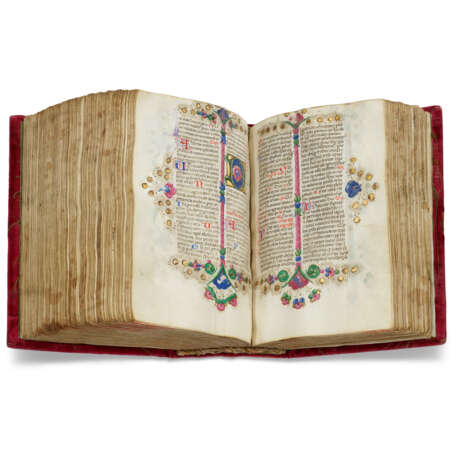ID 794539
Lot 31 | Circle of Taddeo Crivelli
Valeur estimée
£ 40 000 – 60 000
Breviary, for Franciscan use, in Latin, illuminated manuscript on vellum [Ferrara, c.1465]
A work of great elegance and svelte finish produced for a Franciscan house: a sumptuous and representative example, with illuminated borders on every page, of the work of the Ferrarese illuminators responsible for the Bible of Borso d’Este.
136 x 92mm. 507 leaves, collation: 16, 28 (of 10, lacking i and x), 3-610, 79 (of 10, lacking x), 8-1710, 189 (of 10, lacking x), 199 (of 10, lacking viii), 208 (of 10, lacking iv-v), 21-2210, 238 (of 10, lacking ix-x), 249 (of 10, lacking i), 25-3010, 316, 328 (of 10, lacking i and x), 33-3410, 358 (of 10, lacking v-vi), 3610, 378 (of 10, lacking v-vi), 388 (of 10, lacking v-vi), 39-4010, 418 (of 10, lacking i-ii), 42-4810, 495 (of 6, lacking ii), 50-5110, 524 (of 6?, lacking iii-iv), 53-5410, 556 (of 8, lacking i-ii), most catchwords survive, modern sporadic foliation in pencil followed here, 31 lines of text in two columns, ruled space: 82 x 28mm, initials in red or blue with purple or red penwork decoration throughout, rubrics in red, 36 large and 1 historiated initial, every single page with illuminated borders with flowers, scrolling acanthus, bezants and scrolls (lacking probably 25 leaves, likely with historiated initials, minimal marginal cropping, stains to ff.35-38, occasional marginal staining, occasional flaking to burnished gold and a few losses of pigment to border decoration). Red velvet over wooden boards, brass catch and clasp (edges a little worn).
Provenance:
(1) The preponderance of Franciscan saints and feasts in the Calendar (including the birth, stigmatisation, translation and octave of St Francis; the feasts of St Anthony of Padua, St Claire and St Bernardino of Siena, canonised in 1450), and the focus on St Francis in the Sanctoral (ff.453 and following) indicate that the manuscript was produced for a Franciscan house in or around Ferrara (on the basis of the illumination).
(2) Sister Polissena: 16th-century inscription, now partially erased, on f.2v ‘[Hic] liber est sororis Polissena […]’.
Content: Calendar ff.1-6v; Temporal, from Advent to Holy Saturday (lacking opening), ff.7-90; Canticles and Litany ff.90-93v; Temporal from Easter Sunday to the third Sunday in November (lacking ending) ff.93v-217v; Ferial Psalter (lacking opening), ff.218-292v; Sanctoral (lacking opening), from St Andrew to St Catherine of Alexandria (25 November) ff.293-479v; Common of Saints (lacking opening) ff.480-496; Hours of the Virgin ff.496-500v; Office of the Dead ff.500v-504v; rubrics ff.504v-507.
Illumination:
The style of illumination is typical of Ferrarese manuscript production of the second half of the 15th century, and recognisably similar to the repertoire of the illuminators of the Bible of Borso d’Este, Duke of Ferrara (Modena, Bibl. Estense Universitaria, Lat.422-3). The Bible was produced in Ferrara between 1455 and 1461, and the two principal artists responsible for its illustration and decoration were Taddeo Crivelli and Giorgio d’Alemagna, favoured illuminators of the Duke. Gaudenz Freuler notes that the style of the surviving historiated initial with the Virgin and Child in the present manuscript (f.32v) closely resembles Crivelli’s Virgin and Child in the Gualenghi-d’Este Hours at the Getty (Los Angeles, John Paul Getty Museum, Ms. Ludwig IX, f.4), which he illuminated with Guglielmo Giraldi. Indeed, close analogies can be drawn between the borders in our manuscript, with their elaborate leafy sprays peppered with gold bezants and palette of lilacs, greens and blues, and the borders of the Getty manuscript, and also (to a lesser extent) with those found in the now dispersed Breviary of Lionello d’Este (the so-called ‘Llangattock Breviary). Analogies can further be made with the illumination of the Bible and choirbooks made for the Certosa of Ferrara in the 1460s and early 70s (Ferrara, Museo di Schifanoia – see F.Toniolo, ed., La miniatura a Ferrara dal tempo di Cosmè Tura all'eredità de Ercole de' Roberti, 1998, p.223).
Special notice
No VAT on hammer price or buyer's premium.
| Lieu d'origine: | Italie, Europe |
|---|---|
| Catégorie maison de vente aux enchères: | Manuscrits médiévaux et de la Renaissance |
| Lieu d'origine: | Italie, Europe |
|---|---|
| Catégorie maison de vente aux enchères: | Manuscrits médiévaux et de la Renaissance |
| Adresse de l'enchère |
CHRISTIE'S 8 King Street, St. James's SW1Y 6QT London Royaume-Uni | |
|---|---|---|
| Aperçu |
| |
| Téléphone | +44 (0)20 7839 9060 | |
| Commission | see on Website | |
| Conditions d'utilisation | Conditions d'utilisation |







